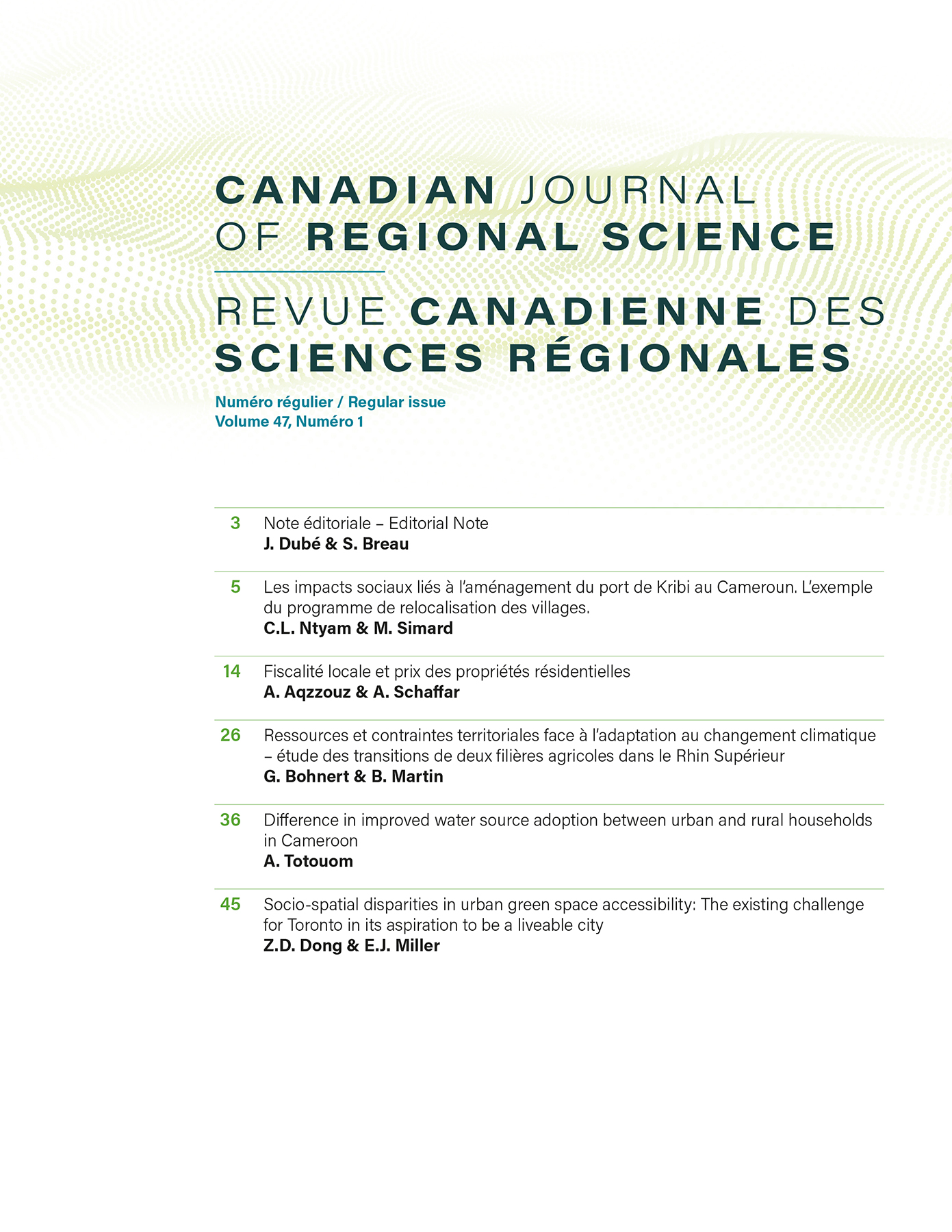Résumés
Abstract
Many households living in developing countries still collect water from unimproved sources. The situation is particularly worse in rural areas. This study analyses the differences in improved water source adoption between urban and rural households in Cameroon. Our analysis uses data from the fifth Cameroon Demographic and Health survey conducted in 2018-2019. Results from logit regressions suggest that the use of improved water source increases when the head of household is a woman. It also increases with education, access to information and wealth. Conversely, it decreases with household size. The approach of Fairlie (2006) is further used to evaluate the contribution of the above factors to urban-rural differences in the adoption of improved water sources. Our analysis shows that the above factors explain 41% of the differences in water source choices observed between urban and rural households. The policy recommendations of the research are described in the paper.
Keywords:
- Adoption of improved water source,
- determinants of adoption,
- urban-rural gap
Parties annexes
Bibliography
- Abebaw, D., Tadesse, F. & T. Mogues. (2010). Access to Improved Water Source and Satisfaction with Services Evidence from Rural Ethiopia, International Food Policy Research Institute Discussion Paper 01044.
- Adams, E. A., Boateng, G. O. & J A. Amoyaw. (2016). Socioeconomic and Demographic Predictors of Potable Water and Sanitation Access in Ghana, Social Indicators Research, 126 (2): 673-687.
- Akerlof, G.A. (1970). The Market for “Lemons”: Quality Uncertainty and the Market Mechanism, The Quarterly Journal of Economics, 84(3): 488-500
- Atangana Ondoua H. (2021). Inequality in the Distribution of Electricity and Water in Urban Areas: The Case of Cameroon, The Journal of Energy and Development, 45(1-2): 65-91.
- Barnwal, P., Van Geen, A., Von Des Goltz, J. & Singh, C.K. (2017). Demand for Environmental Quality Information and Household Response: Evidence from Well-water Arsenic Testing, Journal of Environmental Economics and Management, 86: 160–192.
- Basani, M., Isham, J. & Reilly, B. (2008). The Determinants of Water Connection and Water Consumption: Empirical Evidence from a Cambodian Household Survey, WorldDevelopment, 36 (5): 953–68.
- Blinder, A. (1973). Wage Discrimination: Reduced Form and Structural Estimates, Journal of Human Resources 8 (4): 436–55.
- Boone, C., Glick, P. & Sahn, D.E. (2011). Household Water Supply Choice and Time Allocated to Water Collection: Evidence from Madagascar, Journal of Development Studies, 47 (12): 1826-1850.
- Breuil L. (2004). Renouveler le partenariat public-privé pour les services d’eau dans les pays en développement, comment conjuguer les dimensions contractuelles, institutionnelles et participatives de la gouvernance ? Thèse pour obtenir le grade de Docteur de l’Ecole Nationale du Génie Rurale, des Eaux et Forêts, Centre de Paris.
- Briand, A. & Loyal, A. (2013). La demande de raccordement des ménages auprès des petits opérateurs privés d’eau potable, le cas des quartiers périphériques de Maputo, Revue Economique, 64 (4): 685-719.
- Briand, A., Nauges, C., Strand, J. & Travers, M. (2010). The Impact of Tap Connection on Water Consumption Patterns: The Case of Household Water Use in Dakar, Senegal, Environment and Development Economics, 15 (1): 107-126.
- Etia, F. C. D., Mvogo, G., & Bidiasse, H. (2022). Les déterminants d’accès à l’eau potable au Cameroun, African Development Review, 34 (1): 154-170.
- Fairlie, R-A. (2006). An Extension of the Blinder-Oaxaca Decomposition Technique to Logit and Probit Models. IZA Discussion Paper No. 1917.
- Institut National de la Statistique & ICF. (2020). Enquête Démographique et de Santé du Cameroun 2018.Yaoundé, Cameroun et Rockville, Maryland, USA : INS et ICF.
- Jalan, J., Somanathan, E., & Chaudhuri, S., (2009). Awareness and the Demand for Environmental Quality: Survey Evidence on Drinking Water in Urban India, Environment and Development Economics 14 (6): 665–692.
- Jaglin S. (2001). L’eau potable dans les villes en développement : les modèles marchands face à la pauvreté. Revue du Tiers Monde, T. XLII, N° 166, pp. 275-303
- Larson, B., Minten, B. & Razafindralambo, R. (2006). Unravelling the Linkages between the Millennium Development Goals for Poverty, Education, Access to Water and Household Water Use in Developing Countries: Evidence from Madagascar, Journal of Development Studies, 42 (1): 22–40.
- McFadden, D. (1974). “Conditional Logit Analysis of Qualitative Choice Behavior”. In P. Zerembka (Eds). Frontiers in Econometrics, New York: Academic Press; 105–142.
- Mu, X., Whittington, D. & Briscoe, J. (1990). Modelling Village Water Demand Behavior: A Discrete Choice-Choice Approach, Water Resources Research, 26: 521-529.
- Nauges, C. & Van Den Berg, C. (2009). Demand for Piped and Non-piped Water Supply Services: Evidence from Southwest Sri Lanka, Environmental and Resource Economics, 42 (4): 535–549.
- Nauges, C. & Whittington, D. (2010). Estimation of Water Demand in Developing Countries: An Overview, World Bank Research Observer, 25 (2): 263-294.
- Oaxaca, R. (1973). Male–female Wage Differentials in Urban Labour Markets, International Economic Review, 14: 693–709.
- Persson, H.T. (2002). Household Choice of Drinking-water Source in the Philippines, Asian Economic Journal, 16 (4): 303- 316.
- Singh S, Ranjan R, & Gonsalves O-N. (2020). Decomposing the Gaps in Access to LPG across Socio-Religious Groups in Rural India. Journal of Social Inclusion Studies 6 (1): 97–112.
- Stigler, G.J. (1961). The Economics of Information, Journal of Political Economy, 69 (3): 213-225.
- Totouom, A. (2020). Determinants of Pipe-borne Water Consumption by Urban Households in Cameroon, Mondes en Développement, 190 (2): 151-170.
- Totouom, A., Fouéka, S. & Ngouhouo, J. (2018). Determinants of the Avoidance Behaviour of Households to Cope with Unsafe Drinking Water: Case Study of Douala and Yaoundé in Cameroon, Review of Agricultural, Food and Environmental Studies, 99(2): 121-148.
- Wooldridge, J.M. (2002). Econometric Analysis of Cross Section and Panel Data. The MIT Press. Cambridge, Massachusetts London, England.
- World Health Organization (2023). https://www.who.int/fr/news-room/fact-sheets/detail/drinking-water
- World Health Organization (WHO) and the United Nations Children’s Fund (UNICEF) (2017). ‘Progress on drinking water, sanitation and hygiene: 2017 update and SDG baselines’, Licence: CC BY-NC-SA 3.0 IGO.
- Zoungrana, T.D. (2021). Les déterminants du choix d’approvisionnement en eau potable des ménages ruraux de la commune de Koudougou au Burkina Faso. Économie rurale. DOI : https://doi.org/10.4000/economierurale.9135

